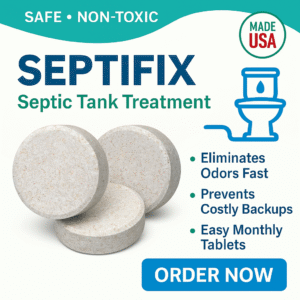Thinking about hooking up an addition, guest house, RV, or new building to an existing septic system? It’s a common question for property owners looking to save money and avoid installing a whole new tank. But before you dig, here’s what you need to know about legality, risks, and best practices for connecting to an existing septic system—plus the top tools to make the job easier and safer.
Quick Picks: Best Tools for Septic System Connection & Maintenance
-
Best Overall:
Fernco Flexible Coupling for Sewer/Drain Pipe -
Best Budget:
Oatey 4-inch PVC Tee -
Best Premium:
Goplus Pipe Inspection Camera
Buyer’s Guide: Can You Legally Hook Into an Existing Septic System?
- Permits Are Required: In almost every US state and Canadian province, you must get a permit and official approval before adding any new structure or plumbing to an existing septic system.
- System Capacity Matters: Your current septic tank and drainfield must be large enough to handle the increased flow. If not, you may be required to upgrade or install a larger system.
- Professional Evaluation: Most local codes require a licensed septic professional to inspect and certify your system before it can be expanded. They will look at tank size, drainfield health, soil type, and more.
- Common Additions: Additions like extra bathrooms, guest cottages, garages with sinks, or RV hookups all require evaluation. Never assume you can just “tap in” to the old pipe without checking the rules.
- Risks of Skipping Permits: Connecting illegally can lead to fines, system failure, sewage backups, groundwater contamination, and major headaches during home sales or refinancing.
- Exceptions: Some rural areas may allow simple add-ons for sheds or basic graywater (like a single laundry sink), but most require full permitting and inspection for any increase in wastewater volume.
Bottom line: You can connect to an existing septic system—if it’s properly permitted, evaluated, and sized for the new load. Always call your local health department or permitting office first.
Full Reviews: Top Tools for Septic Connections & Maintenance
Fernco Flexible Coupling for Sewer/Drain Pipe
Who it’s for: Homeowners and pros needing a tight, leak-free connection between new and existing drain pipes.
- Key Benefits:
- Flexible rubber fits PVC, cast iron, and clay pipes
- Stainless steel clamps for a secure seal
- Easy to install—no glue or cement needed
- Pros:
- Works for both repairs and add-ons
- Lasts for years, even underground
- Trusted by plumbers and inspectors
- Cons:
- Requires proper sizing—measure before ordering
- Doesn’t replace full permitting or inspection
Final Verdict: Best for simple, code-compliant connections to an existing system.
Buy Fernco Coupling.
Oatey 4-inch PVC Tee
Who it’s for: DIYers and pros expanding or adding branch lines to an existing septic or drain system.
- Key Benefits:
- Schedule 40 PVC fits standard 4-inch drain pipes
- Great for adding new bathroom or utility lines
- Meets all major plumbing codes
- Pros:
- Easy to glue and set
- Affordable and widely available
- Strong and reliable connection
- Cons:
- Permanent—must cut pipe to install
- Not flexible for odd angles or repairs
Final Verdict: Excellent for basic branch line additions—just check local code first.
Order Oatey Tee.
Goplus Pipe Inspection Camera
Who it’s for: Homeowners, inspectors, or plumbers wanting to check system condition before connecting or for routine maintenance.
- Key Benefits:
- Waterproof camera inspects up to 100 feet
- Color LCD screen and video recording
- Essential for diagnosing clogs or locating access points
- Pros:
- Saves money on unnecessary digging
- Helps verify line condition before connecting
- Great for ongoing septic care
- Cons:
- Upfront cost (but pays for itself fast)
- Learning curve for first-time users
Final Verdict: A wise investment for big projects or regular septic maintenance.
See Goplus Camera.
Comparison Table: Best Tools for Septic Connections
| Name | Key Features | Specs/Capacity | Price Link |
|---|---|---|---|
| Fernco Flexible Coupling | Flexible, fits many pipe types | 4″ standard size | View Price |
| Oatey 4″ PVC Tee | Code-compliant, easy to glue | 4″ Schedule 40 | View Price |
| Goplus Inspection Camera | 100ft cable, waterproof camera | LCD screen, 8GB card | View Price |
Frequently Asked Questions (FAQ)
Can I connect an addition or garage to my current septic?
Yes, but only with a permit and professional evaluation confirming the system’s capacity. Your local health department will have the final say.
Do I need to upgrade my septic to add a new bathroom?
Maybe. If your current tank or drainfield is too small, an upgrade or expansion is usually required.
Is it legal to hook up an RV to my house septic?
Often yes, if you have proper permits and the system is large enough. Permanent RV hookups sometimes require a separate system—check your county rules.
What are the risks of “just tapping in” without a permit?
You risk fines, insurance problems, failed inspections, and costly repairs. Unapproved connections can cause system overload or groundwater pollution.
How do I know if my septic can handle extra flow?
Have a licensed septic professional assess tank and drainfield size, soil absorption, and current load before adding anything new.
Conclusion & Call to Action
Hooking into an existing septic system is possible—but never a “just do it” project. Always check local codes, get the right permits, and have your system evaluated before connecting any new plumbing or structures. Protect your investment and avoid future headaches!
Need to expand or connect? Use the right tools, follow the law, and always consult a septic pro before making changes to your system.
